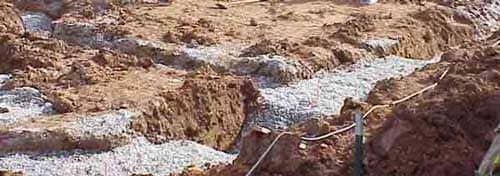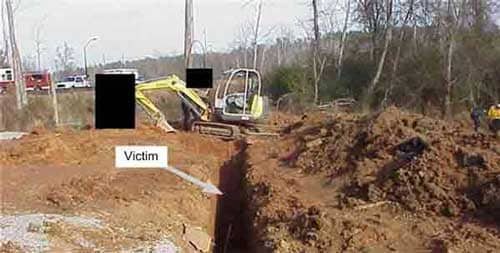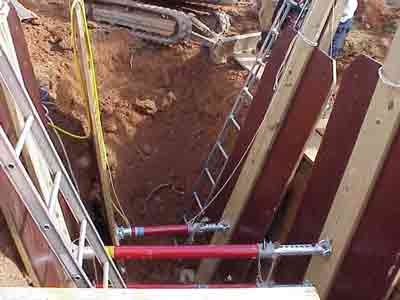Hispanic Laborer Dies After Footing Collapse - North Carolina
NIOSH In-house FACE Report 2005-04
August 22 , 2007
Summary
On December 31, 2004, a 32-year-old Hispanic laborer (the victim) was killed when the side wall of an eight-foot-deep trench collapsed. The victim was a member of a five-man crew that had been contracted to prepare an excavation for a concrete footing that would support the concrete basement for a new single-family, private residence in a housing development. The crew consisted of the company owner, a Hispanic crew leader who spoke little English, and three Hispanic laborers that spoke only Spanish. The depth of the excavation ranged from approximately two to three feet; however, due to a change in the building plans that included the addition of an additional garage stall, the crew had reached a backfilled area where the depth of the trench reached eight feet when the incident occurred. The company owner was operating the mini-excavator until he had to leave the site to run some errands. When he left, he instructed the crew leader to operate the mini-excavator.
As the crew leader was operating the mini-excavator, the victim entered the trench at the shallow end and walked to the deep end to clean loose dirt from the floor with a shovel. As the crew leader yelled for him to exit the trench, the side wall of the trench began to collapse. The victim tried to run to the shallow end, but was covered up. The crew tried to dig the victim out while a nearby homeowner called 911. Upon arrival, fire department personnel ordered the workers out of the trench. They then installed trench bracing, entered the trench, and removed the victim, who was pronounced dead at the scene. NIOSH investigators concluded that, to help prevent similar occurrences, employers should
- ensure that a competent person conducts daily inspection of excavations, adjacent areas, and protective systems and takes appropriate measures necessary to protect workers
- ensure that workers are protected from cave-ins by an adequate protective system
- develop, implement and enforce a comprehensive safety program, and provide safety training in language(s) and literacy level(s) of workers, which includes training in hazard recognition and the avoidance of unsafe conditions
- ensure that only qualified rescue personnel who have assumed responsibility for rescue operations and site safety should attempt rescue operations.
Introduction
On December 31, 2004, a 32-year-old Hispanic laborer (the victim) was killed when the side wall of an eight-foot-deep trench collapsed. On January 13, 2005, officials of the North Carolina Occupational Safety and Health Administration (NCOSHA) notified the Division of Safety Research (DSR) of the incident. On February 3-4, 2005, a DSR senior investigator conducted an investigation of the incident. The case was reviewed with the NCOSHA compliance officer assigned to the case, the city fire department and the company owner. The coroner’s report was reviewed. The incident site was visited but it could not be determined exactly where the incident took place since work on the project had been completed. Photographs taken by NCOSHA immediately after the incident were obtained and used in this report.
The employer was an excavation contractor that had been in business by himself since July 3, 2001. Prior to that, he had worked for his father performing the same type of work for more than eleven years. He employed four to five workers depending on the number of jobs he had. The employer had no written safety program. Workers were trained on the job. The four workers employed at the time of the incident were Hispanic. The crew leader spoke enough English to understand work instructions given by the owner. The other three workers did not speak English. None of the workers had received any training pertaining to working in excavations or trenches, although all stated, through an interpreter during OSHA interviews, that they had been told not to go into the trench. The victim had worked for the employer for approximately two months. This was the first fatality experienced by the employer.
Investigation
The employer had been contracted to excavate a footing for a private residence to be constructed, and then form and pour the concrete footing. The owner stated that the excavations usually ranged from two to less than three feet in depth, and two to three feet wide, and that the concrete footings were usually poured on solid ground. Workers occasionally entered the excavations to check the firmness of the floor or to remove excess soil. The employer and his crew had been at the site for approximately two weeks when the owners of the residence decided they wanted a three-car garage instead of a two-car garage. The employer left the site while a second contractor came to the site to backfill the area that would accommodate the extra garage stall. When the second contractor completed backfilling the area, the employer returned to the site with his four-man crew.
On the second day back at the site, the owner began to excavate the backfilled area at approximately 7:00 a.m. with a mini-excavator equipped with a 24-inch wide bucket. The length of the front of the backfilled garage area was approximately 35 feet. To keep the floor of the excavation level, the depth ranged from two to eight feet deep from the front of the trench to the far end. The trench was to be filled with gravel up to a depth where the footing could be poured.
As the owner operated the mini-excavator, the crew leader operated a small tow motor to push the gravel into the excavation in order to keep the floor of the trench level for the footing (Photo 1).
 |
|
Photo 1. Illustrates the usual depth of the footings and the gravel fill. Photo courtesy of NCOSHA.
|
At approximately 8:00 a.m., the owner left the site to cash the workers’ paychecks and to run various errands. He instructed the crew leader to operate the mini-excavator, then instructed the other men not to enter the trench.
As the crew leader operated the mini-excavator, the victim stood to the side of the trench. The victim’s brother and a coworker went to the other side of the property to set wooden stakes to mark the location of the next footing excavation.
The depth of the trench had reached approximately eight feet at this point. The victim asked the crew leader if he should enter the trench at a shallower spot to remove excess dirt. The crew leader stated during OSHA interviews that he told the victim to stay out.
At approximately 9:45 a.m. the owner returned to the site and began talking with another homeowner. The homeowner was in sight of all crew members. The victim again asked the crew leader if he could enter the trench to clean up loose dirt. The crew leader stated during OSHA interviews that he felt the victim did not want the owner to see him just standing at the side of the trench. The crew leader reportedly then told the victim to go in, but to come straight back out. The victim walked to a point where the excavation was less than five feet deep and jumped in. As the victim was walking toward the deeper end of the trench, the crew leader saw the wall of the trench start to fall away and screamed for the victim to get out. The victim turned and ran about five feet but was covered up when the wall caved in (Photo 2). The crew leader yelled for the other crew members. The owner and homeowner also heard the crew leader and ran to the trench to see what had happened. When it was evident the victim had been covered up, the homeowner called 911. The men tried to dig the victim out while the crew leader used the mini-excavator to remove dirt from the area. The fire rescue squad arrived within minutes and ordered the owner and workers to exit the excavation because of the danger of further cave in. The rescue squad then employed trench plates to secure the sides of the trench and began to uncover the victim (Photo 3). Approximately four feet of dirt had to be removed to completely uncover the victim, who was removed from the trench at 1:35 p.m.
Back to Top
Cause of Death
The coroner listed the cause of death as asphyxiation due to compression of the chest.

|
|
Photo 2. Illustrates the position of the mini-excavator at the time of the incident and the approximate location of the victim. Photo courtesy of NCOSHA
|
Recommendations/Discussion
Recommendation #1: Employers should ensure that a competent person conducts daily inspections of excavations, adjacent areas, and protective systems and takes appropriate measures necessary to protect workers.
Discussion: Although the contractor had not been contracted to perform trenching operations, unusual circumstances were present at the site due to the change in building plans. Regulations and other safety measures pertaining to trenching operations should be followed when excavations exceed four feet in depth. Significant hazards are associated with trenching and similar excavating operations, including cave-in, positioning of machinery, and changes in environmental and physical conditions. For these reasons, 29 CFR 1926.651 (k) (1)1 requires that “daily inspections of excavations, the adjacent areas, and protective systems shall be made by a competent persona for evidence of a situation that could result in possible cave-ins, indications of failure of protective systems, hazardous atmospheres, or other hazardous conditions. An inspection shall be conducted by the competent person prior to the start of work and as needed throughout the shift.” 29 CFR 1926.651 (k) (2)1 requires that “where the competent person finds evidence of a situation that could result in a possible cave-in, indications of failure of protective systems, hazardous atmospheres or other hazardous conditions, exposed employees shall be removed from the hazardous area until the necessary precautions have been taken to ensure their safety.”
a Competent person is defined by OSHA as one who is capable of identifying existing and predictable hazards in the surroundings or working conditions which are unsanitary, hazardous, or dangerous to employees, and who has the authorization to take prompt corrective measures to eliminate them.

|
|
Photo 3. Illustrates the trench plates installed by the rescue squad. Photo courtesy of NCOSHA
|
Recommendation #2: Employers should ensure that workers are protected from cave-ins by an adequate protective system.
Discussion: Due to the backfilling performed due to the change in building plans, the depth of the excavation had reached eight feet. Although the crew was instructed not to enter the excavation, should the need arise for workers to enter an excavation, the applicable OSHA Excavation Standard, 29 CFR 1926.652 (a) (1)1 states that “each employee in an excavation shall be protected from cave-ins by an adequate protective system.” A protective system designed for the soil conditions found in this excavation could have included a trench shield (also known as a trench box), shoring, or a combination of shoring and shielding. Sloping would not have been appropriate because of the sandy composition of the back-filled soil. Employers should consult tables located in the appendices of the OSHA Excavation Standard that detail the protection required based upon the type of soil and environmental conditions present at the site. Employers can consult with manufacturers of protective systems to obtain detailed guidance for the appropriate use of these products. In this incident, no protective system had been placed at any point in the footing excavation.
Recommendation #3: Employers should develop, implement and enforce a comprehensive safety program, and provide safety training in language(s) and literacy level(s) of workers, which includes training in hazard recognition and the avoidance of unsafe conditions.
Discussion: Employers should evaluate tasks performed by workers, identify all potential hazards, and then develop, implement, and enforce a safety program that meets applicable OSHA standards addressing these identified hazards. The safety program should include, at a minimum, worker training in hazard identification, and the avoidance and abatement of these hazards.2 For example, workers need to be trained to recognize potential hazards associated with excavation operations, such as a possible collapse hazard. A rescue plan should be incorporated into a comprehensive safety program. Companies that employ workers who do not understand English should identify the languages spoken by their employees and design, implement, and enforce a multi-language safety program. To the extent feasible, the safety program should be developed at a literacy level that corresponds with the literacy level of the company’s workforce. Employers may need to consider providing special safety training for workers with low literacy to meet their safety responsibilities. The program, in addition to being multi-language, should include a competent interpreter to explain worker rights to protection in the workplace, safe work practices workers are expected to adhere to, specific safety protection for all tasks performed, ways to identify and avoid hazards, and who they should contact when safety and health issues arise.
The victim had been told by the employer and coworkers not to enter the excavation under any circumstances; however, since he had received no training pertaining to trenching operations, it is unlikely that he really understood the hazards associated with entering the excavation, particularly the collapse hazard associated with the backfilled soil.
Recently, OSHA developed the Compliance Assistance: Hispanic Employers and Workers web page to assist employers with a Spanish-speaking workforce in learning more about workplace rights and responsibilities, identifying Spanish-language outreach and training resources, and learning how to work cooperatively with OSHA. In addition, the Compliance Assistance: Hispanic Employers and Workers web page provides a list of OSHA’s Hispanic/English-as-a-second-language coordinators. These materials are available at https://www.osha.gov/dcsp/compliance_assistance/index_hispanic.htmlexternal icon3 or can be obtained by contacting an area OSHA office. Information provided can be used by employers who are developing or improving safety and training programs for their Spanish speaking employees.
Recommendation #4: Employers should ensure that only qualified rescue personnel who have assumed responsibility for rescue operations and site safety should attempt rescue operations.
Discussion: Although not a factor in this incident, no rescue plan for the site existed and untrained coworkers tried to uncover the victim from the trench before trained rescue personnel arrived at the scene. When the rescue personnel arrived, they reportedly had to remove the untrained workers from the trench before rescue operations could commence. Workers should never, under any circumstances, enter a hazardous environment to attempt a rescue operation unless properly equipped and trained in the use of the equipment and methods required for rescue. In this instance, untrained workers entered the trench and tried to uncover the victim, placing themselves at risk of becoming victims themselves. Only those persons trained in the requirements of NFPA 16704 should attempt rescue operations after a trench cave-in occurs. All persons at the incident site should follow the directions given by the Incident Commander or his/her designee in order to provide the most optimal circumstances for the safety of all persons on the site during rescue operations.
References
- 29 CFR 1926.650 (2006). Excavations: Code of Federal Regulations, Washington D.C.: U.S. Government Printing Office, Office of the Federal Register. https://www.osha.gov/pls/oshaweb/owadisp.show_document?p_table=STANDARDS&p_id=10774external icon
- Code of Federal Regulations [2006]. 29 CFR 1926.21(b)(2). Safety Training and Education. Washington, DC: U.S. Printing Office, Office of the Federal Register.
- OSHA [2005]. Compliance Assistance: Hispanic Employers and Workers web page. Accessed April 7, 2005 at https://www.osha.gov/dcsp/compliance_assistance/index_hispanic.htmlexternal icon.
- NFPA [1999]. NFPA 1670, Standard on operations and training for technical rescue incidents 1999 Edition, Chapter nine, trench and excavation. Quincy, MA; National Fire Protection Association.
Investigator Information
This investigation was conducted by Virgil Casini, Senior Investigator, Fatality Investigations Team, Surveillance and Field Investigations Branch, Division of Safety Research.
